Forums:
I had the pleasure of a geology field trip to Utah last week and thought you might enjoy seeing some of the wonderful plants and desert mountain scenery from the various sites we stopped at.
Scenery near the old coal-mining town of Helper, SE of Salt Lake City: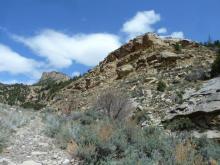

I haven't ID'd many of the plants yet so please speak up if you know what they are. The first appears to be an Astragalus/Oxtropis and the second looks like Cymopteris sp.... that's as far as I've gotten!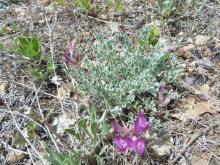
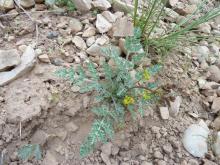
Sagebrush (Artemisia tridentata) was very common: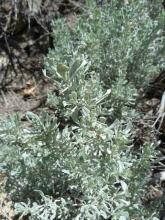
Physaria sp. on an eroded sunny bank: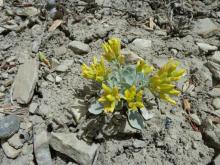


Ephedra viridis, Mormon tea, was very common too; this individual shows a golden-foliaged sport: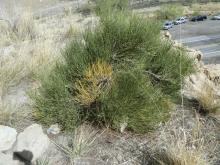


Comments
Lori S. (not verified)
Re: Utah desert plants
Mon, 05/07/2012 - 9:43pmPetroglyphs... the hunch-backed flute-player, Kokopelli, is shown on the lower right:
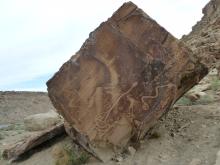
Round-leaved buffaloberry, Shepherdia rotundifolia (x2):

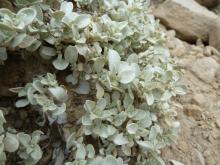
Unknown Brassicacaea:
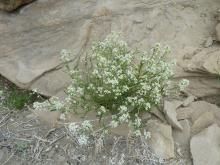
Cryptantha crassisepala?
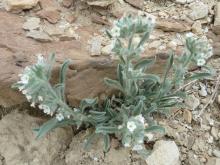
Dried skeleton of Eriogonum inflatum:

Castilleja sp.:
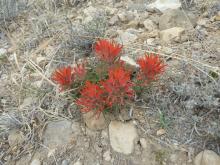
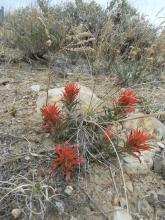
Trond Hoy
Re: Utah desert plants
Tue, 05/08/2012 - 10:32amOh yes! Thank you Lori!
John P. Weiser
Re: Utah desert plants
Tue, 05/08/2012 - 1:45pmThe Castilleja species looks like Castilleja chromosa. Here are some photos for comparison.
http://www.flickr.com/photos/sierrarainshadow/sets/72157603721807736/
The Astragalus could be Astragalus utahensis but I can't be sure.
Looks like you got out into some remote areas.
Mark McDonough
Re: Utah desert plants
Tue, 05/08/2012 - 4:12pmGreat scenery and plants! Nice to be able to travel for work and get some botanizing in. I agree with John's ID, the Astragalus does look like A. utahensis, here are some links:
Anne Spiegal grows Astragalus utahensis in New York State.
http://www.srgc.net/forum/index.php?topic=4656.msg243616#msg243616
Calphoptos:
http://calphotos.berkeley.edu/cgi/img_query?where-genre=Plant&testing=123&query_src=photos_flora_index&rel-taxon=contains&where-taxon=Astragalus+utahensis&rel-namesoup=matchphrase&where-namesoup=&where-lifeform=any&rel-location=matchphrase&where-location=&rel-country=eq&where-country=any&rel-state=eq&where-state=any&where-county=any&where-collectn=any&rel-photographer=eq&where-photographer=any&rel-kwid=equals&where-kwid=
...and a form of A. utahensis that won a Forrest Medal at an SRGC plant show:
http://www.srgc.net/forum/index.php?action=dlattach;topic=9003.0;attach=...
...another Scottish show plant:
http://www.srgc.net/forum/index.php?topic=5400.msg150706#msg150706
The Cymopterus looks similar to C. acaulis and C. longipes, but take bets that it is indeed Cymopterus longipes, here are a few photo linnks to that species.
http://www.flickr.com/photos/tonyfrates/5583881156/
http://www.flickr.com/photos/zharkikh/6828827588/
http://www.flickr.com/photos/zharkikh/6254027970/
Richard T. Rodich
Re: Utah desert plants
Tue, 05/08/2012 - 7:15pmOf course, from my prospective, all mountainous scenery is spectacular, but I assume there is something geologically special about this area?
Never heard of Eriogonum inflatum before, and had to go read up on its peculiarly fascinating growth. Has any of you in the northern reaches grown it?
John P. Weiser
Re: Utah desert plants
Tue, 05/08/2012 - 7:48pmDon't grow it but I've popped quite a few. :rolleyes:
It is an annual and grows anywhere from 6"-2'tall depending on available spring moisture. The inflated portion of the stem is hollow and when they are green can be squeezed and popped just like bubble wrap.
Here are photos of small plants blooming in a very dry environment. The plants are only about 6" tall.
http://www.flickr.com/photos/sierrarainshadow/sets/72157626811038726/wit...
Mark McDonough
Re: Utah desert plants
Tue, 05/08/2012 - 8:33pmEriogonum inflatum is one of those species that demonstrates each species in the genus must be evaluated for garden-worthiness, and certainly some of the desert oddity species are exactly that, desert oddities. Aside from the weird inflated stems, like Allium fistulosum, there is little to recommend for this rather ugly oddity (that said, it is interesting to learn about such odd creatures, to give perspective to the genus variability).
http://www.laspilitas.com/nature-of-california/plants/eriogonum-inflatum
http://www.wildutah.us/html/plants_scenery/h_trumpet_desert.html
http://www.mojavenp.org/Eriogonum_inflatum.htm
http://learningtolivehere.wordpress.com/2010/06/05/vegetation/
Lori S. (not verified)
Re: Utah desert plants
Tue, 05/08/2012 - 9:03pmThanks for the ID suggestions - I'll add them to my photos!
We were off the beaten tracks a couple of times with short hikes, but generally not far off the highway, though certainly in some sparsely inhabited areas.
Yes, the area has fabulous exposures of an essentially complete range of geological environments, from alluvial fans to braided streams to meandering streams to delta fronts and turbidites to aeolian dunes. I won't dwell on that here but it was fantastic!
More of what appeared to be the same Castilleja:
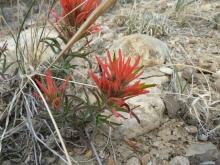
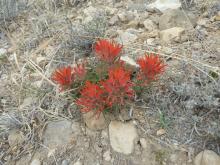
Sphaeralcea coccinea, I think(?):
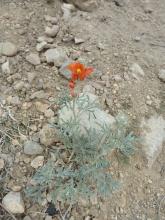
Some stunningly-colored cactus flowers!
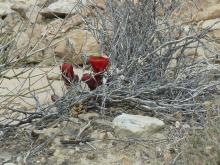
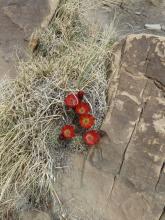
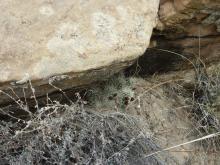

Scenery:
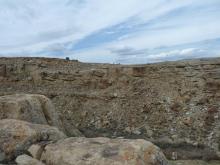

More Cryptantha crassisepala(?):
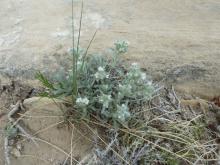
Lori S. (not verified)
Re: Utah desert plants
Tue, 05/08/2012 - 9:18pmWeird but fascinating... I always get a kick out of seeing this plant! :)
Petroglyphs:

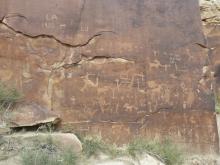
Skunkbush sumac, Rhus trifoliata... which we've seen in the wild through North Dakota and is hardy here, by the way:
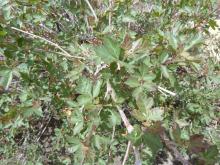
Rock garden with a pretty little pinyon(?) pine:
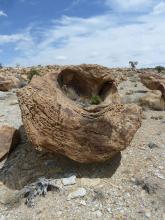

Cute little Hymenoxys(?):
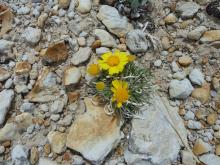
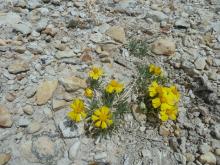
And getting down to the Capital Reef National Park area, where the (largely) aeolian sandstone cliffs turn red:

(More to follow...)
Tim Ingram (not verified)
Re: Utah desert plants
Wed, 05/09/2012 - 7:16amNow if I had a trough like that for a dwarf pine I would be happy! Fascinating plants, especially the Cymopterus. No wonder I find so many difficult to grow here! The Shepherdia is very impressive and I have raised this from seed but not managed to grow it on - there is a superb picture of it in Alpines '86. I imagine year round cover could be essential for plants like this here, and even then light levels would be limited. Lovely to see them in the wild.
Lori S. (not verified)
Re: Utah desert plants
Sat, 05/12/2012 - 8:43pmOutside the hotel in Torrey, there was a disturbed area that, nonetheless, was host to some very enjoyable plants. In the early morning light, Oenothera caespitosa - what a beauty!


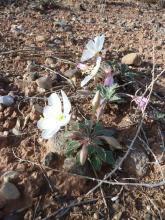
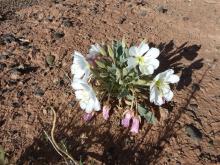
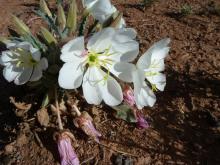
Abronia argillosa?:


A white-flowered Astragalus, I assume:
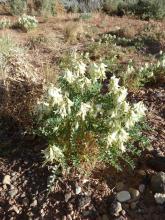
Barrel cactus of some sort:
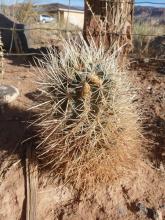
And later in the day...
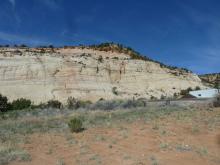
Lori S. (not verified)
Re: Utah desert plants
Sat, 05/12/2012 - 9:01pmHuge aeolian dunes:
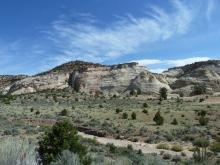
Unknown penstemon:
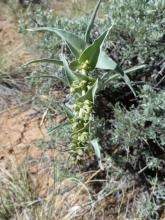
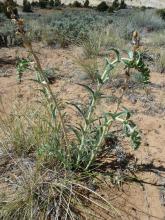
Opuntia, in bud:
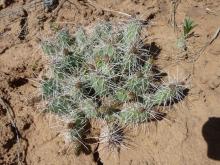
Another Cryptantha(?):
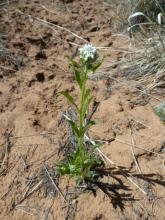
Astragalus/Oxtyropis:
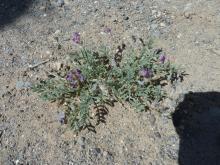
Scenery along Devil's Backbone highway:
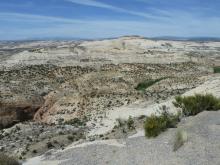
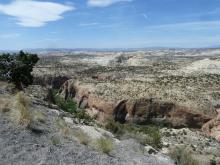
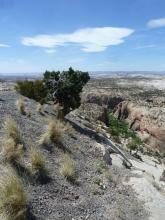
Lori S. (not verified)
Re: Utah desert plants
Sat, 05/12/2012 - 9:03pmMore from Devil's Backbone highway - unknown Gilia/Ipomopsis:

Asteraceae:

And moving on to a Lake Powell viewpoint, prince's plume, Stanleya pinnata:
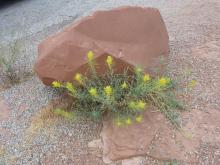
(By the way, I'm on Edward Abbey's side re. Lake Powell... if you know of Edward Abbey, you'll know what I mean!)
Lake Powell - a misfit pool of stagnant water in the desert:

Unknown shrub:
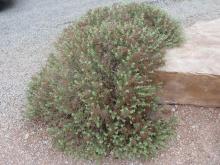

Lori S. (not verified)
Re: Utah desert plants
Sun, 05/13/2012 - 7:52amMore aeolian (wind-blown) dunes, frozen in time...
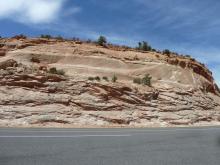
Cliffrose, Purshia mexicana, starting to bloom:
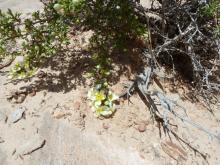
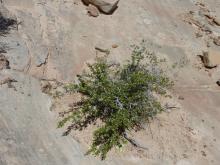
Asteraceae:
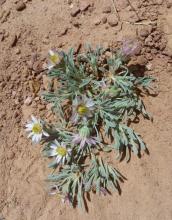
Unknown astragalus(?):
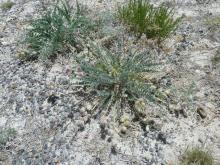
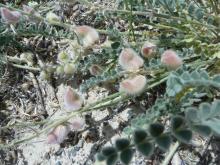
Modern sand dunes, a reworking of sand eroded from the ancient aeolian dunes...
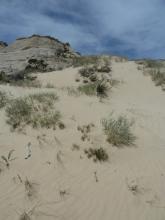
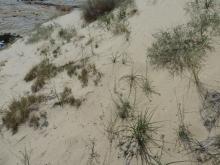
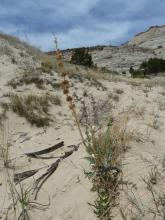
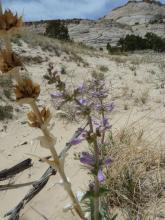
Richard T. Rodich
Re: Utah desert plants
Sun, 05/13/2012 - 6:54pmReally spectacular, Lori. you "picked" a good time to go out there. Amazing that those dunes could be "frozen" hard like that. I can only imagine the thrill for you, having a special interest in geology.
Is Lake Powell a salty, Dead Sea like body of water?
Trond Hoy
Re: Utah desert plants
Sun, 05/13/2012 - 11:24pmLake Powell is man-made I assume, and loosing water due to low precipitation/high demand for water. I read a story about it somewhere - possibly National Geographic.
Thank you Lori for sharing those pictures!
Lori S. (not verified)
Re: Utah desert plants
Sat, 05/19/2012 - 8:45pmMore from the dunes (modern, that is)...
Visitor center at Capitol Reef N.P.:
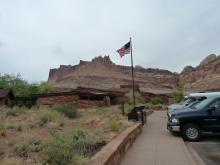
Lori S. (not verified)
Re: Utah desert plants
Sun, 05/20/2012 - 8:15amSome early morning photos while wandering around the roadside sand dunes outside the hotel in the little town of Bluff:
Oenothera pallida?:
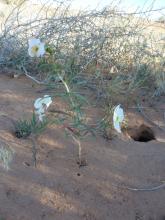
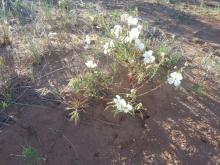

Lygodesmia sp, possibly L. arizonica?:

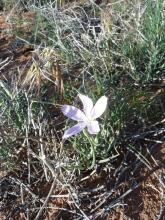
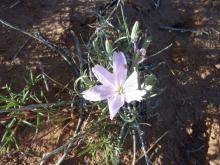
Unknown - the foliage rosettes of this plant were shown in some earlier photos:
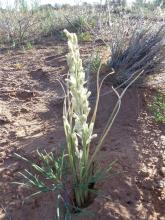
Cleome lutea:

Gaillardia pinnatifida?:
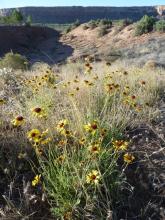
Rumex hymenosepalus?:
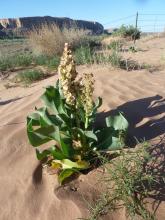
Lori S. (not verified)
Re: Utah desert plants
Sun, 05/20/2012 - 8:27amMore Abronia argillosa(?):
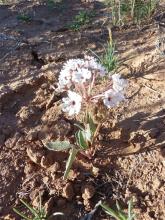
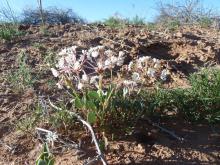
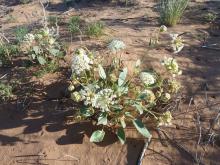
Lupinus sp.:
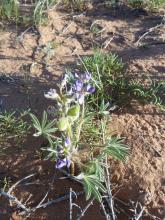

Oenothera pallida(?):

The more subtle beauty of the desert... wind ripples with the tracks of little inhabitants (beetles, lizards perhaps) and windblown grasses...
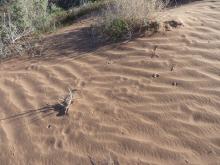
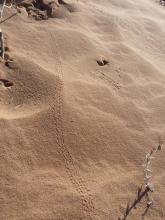
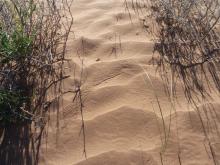
cohan (not verified)
Re: Utah desert plants
Wed, 07/04/2012 - 1:06pmGreat trip, Lori! Look like really soul healing landscapes :)
You may already know, the cactus in reply 8 is an Echinocereus, I'd have to dig for a species name, but maybe coccineus or fendleri etc, not sure of ranges..
Did you figure out your 'lily' in the second last post? I was thinking Hesperocallis (which you probably already considered) with unopened flowers, though those usually have flat, crisped leaves, I did see pics of some with smooth leaves.. of course if those flowers are actually open narrowly, then I have no second thought..lol